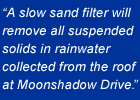
| Home |
| Introduction |
| Hypothesis |
| Methodology |
| Data & Analysis |
| Conclusion |
| Credits |
| Learn More |

 Roof edge |
 Filter media |
 Boulder covers filter slots |
Conclusion
Based upon our prototype testing results, we conclude that a sand filtration system will effectively eliminate all suspended solids and therefore improve the quality of stored rainwater at the Van Asperdt-Boesjes residence.
Because organic particles are removed from rainwater by the sand filter before entering the cistern, the potential for bacterial growth is drastically diminished. Such a filtration system could be easily implemented into the current design and will result in significant water quality improvements.
It should be mentioned however, that the elimination of suspended solids does not equate to water potability. To meet EPA standards for safe drinking, water samples should be tested by a certified laboratory. Many owners of rainwater harvesting systems use chlorine, ozone, or UV purification to ensure that their drinking water is free of pathogens.
 This case study allowed us to learn about water supply on two
very different scales. At the community scale, EWEB's Hayden
Bridge facility embraces water in a technical manner with a
huge supply flume that runs directly through the building's second floor landing. On
a residential scale, the house at Moonshadow Drive celebrates
water in an artistic manner with streams of rainwater falling over
granite boulders. There is also an HVAC intake in the cistern that
provides cooler air to the house, and an acoustic connection
(through vents) to the water dripping into the cistern. By using
water as an organizing principle, the owners of these two buildings of very
different scale have found a way to address their
environmental control needs and make the architecture special at
the same time.
This case study allowed us to learn about water supply on two
very different scales. At the community scale, EWEB's Hayden
Bridge facility embraces water in a technical manner with a
huge supply flume that runs directly through the building's second floor landing. On
a residential scale, the house at Moonshadow Drive celebrates
water in an artistic manner with streams of rainwater falling over
granite boulders. There is also an HVAC intake in the cistern that
provides cooler air to the house, and an acoustic connection
(through vents) to the water dripping into the cistern. By using
water as an organizing principle, the owners of these two buildings of very
different scale have found a way to address their
environmental control needs and make the architecture special at
the same time.
Rainwater Harvesting is a Vital Signs Case Study
prepared by Angela Matt and
Joshua Cohen, Spring 2001.